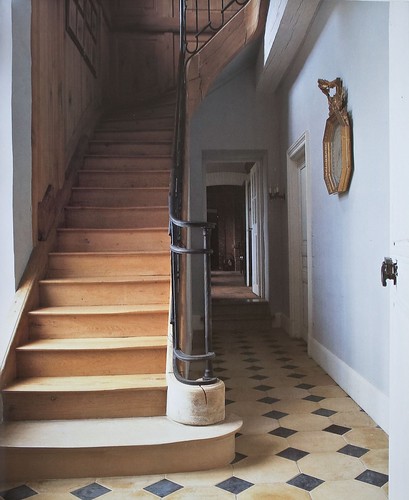
large ✦ larger
Here are a few pages on Frédéric Méchiche from one of my favorite books.
Rooms to Remember, Interiors Inspired by the Past
by Barbara Stoeltie, with photographs by René Stoeltie
Published in 1998, the book features much of Méchiche's work from an earlier period. It's a fascinating look at how his style has evolved and, as Anna of Door Sixteen points out, how he has reworked some of those old sticks of furniture of his.
Please forgive the quality of these images. My scanner is not up to capturing the exquisite ambience of Méchiche's rooms, so I used a digital camera, although my camera skills aren't much better. But here you go. Click on the links for greater detail. Some of these images can also be seen on Google Books. The photos there have clearer detail, although mine are truer in color. Either way, enjoy.
Rooms To Remember
by Barbara Stoeltie, with photographs by René Stoeltie
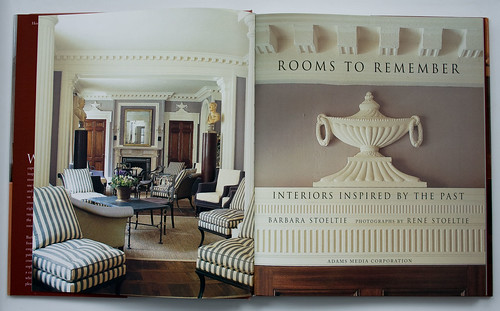
large ✦ larger
Caption for full-page photos (left & right) on Pages 2-3:
"Where once a seventies interior made of formica, plastic, and mirrored wall reigned supreme, Frédéric Méchiche created an Adamesque room with elegant neoclassical features."
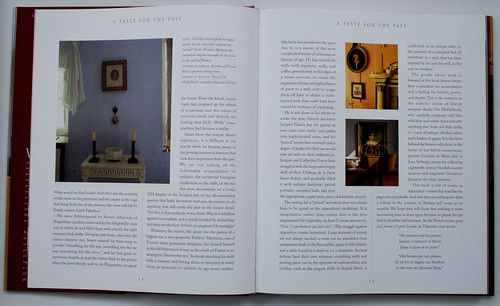
large ✦ larger
Caption for photo (left) on Page 12:
"Still lifes and artfully arranged details are an important element in 'period' rooms. Frédéric Méchiche has created an elegant ensemble in his home in the south of France."
Text on Pages 12-13:
"It is difficult to say exactly when we became aware of the growing interest in interiors that took their inspiration from the past. We are not talking of the fashionable accumulation of antiques, the incidental Georgian candlestick on the table, or the fan that rests decoratively on a Louis XVI bergére in the boudoir, but of the all-consuming passion that leads decorators and non-decorators to do anything that will evoke the past in the tiniest detail. The fact is that suddenly it was there. Was it a rebellion against minimalism and a world invaded by technology and mass production? A form of escapism? Or nostalgia?
Whatever the reason, the desire for the patina of a bygone era is very powerful. Frédéric Méchiche, one of France's most prominent designers, has busied himself in his old fisherman's house in the south of France in an attempt to 'deceive the eye,' furiously attacking his walls with a hammer and having them re-stuccoed as many times as necessary to achieve an age-worn surface. Méchiche has proved over the years that he is a master of the most complicated means of achieving an illusion of age. He has stained his walls with pigment, milk, and coffee, ground away at the edges of a stone staircase to create the impression of wear, and applied layers of paint to a wall, only to scrape them off later to obtain a multi-layered look that could have been caused by centuries of repainting."
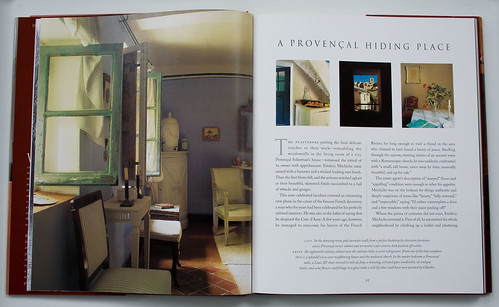
large ✦ larger
Caption for full-page photo (left) on Page 20:
"In the drawing room, pale lavender walls form a perfect backdrop for directoire furniture and a Provençal corner cabinet and terracotta water cistern, both painted off-white."
Caption for photos, left to right, (right) on Page 21:
"An eighteenth-century cabinet near the staircase hides a secret refrigerator. From one of the tiny windows there is a splendid view over neighboring houses and the medieval church. In the master bedroom a Provençal table, a Louis XV chair covered in toile de Jouy, a drawing, a frosted glass candlestick, an antique bottle, and some flowers and foliage in a glass make a still life that could have been painted by Chardin."
Text on Pages 21-23:
A PROVENÇAL HIDING PLACE
"The plasterers putting the final delicate touches to their work - remodeling the windowsills in the living room of a tiny Provençal fisherman's house - witnessed the arrival of its owner with apprehension, Frédéric Méchiche came armed with a hammer and a wicked-looking wire brush. Then the first blows fell, and the artisans watched aghast as their beautiful, skimmed finish succumbed to a hail of whacks and gouges.
"This now-celebrated incident crowned an interesting new phase in the career of the famous French decorator, a man who for years had been celebrated for his perfectly tailored interiors. He was also in the habit of saying that he despised the Côte d'Azur. A few years ago, however, he managed to overcome his horror of the French Riviera for long enough to visit a friend in the area who claimed to have found a haven of peace. Strolling through the narrow, twisting streets of an ancient town with a Romanesque church, he was suddenly confronted with 'a small, tall house, eaten away by time, unusually beautiful, and up for sale.'
"The estate agent's description of 'warped' floors and 'appalling' condition were enough to whet his appetite. Méchiche was on the lookout for things authentic and deeply suspicious of terms like 'luxury,' 'fully restored' and 'impeccable,' saying 'I'd rather contemplate a door and a few windows with their paint peeling off!'
"Where the patina of centuries did not exist, Frédéric Méchiche invented it. First of all, he astonished the whole neighborhood by climbing up a ladder and plastering the entire surface of his facade with an ocher paste, daubing it with evil-smelling mud, and drenching the result with hundreds of gallons of greasy, opaque water to recreate the effect of age. Then a team of masons, carpenters, and painters came and went for six months, and Méchiche spent weeks going around the demolition yards of the region, tracking down eighteenth-century architectural salvage.
"The house was furnished with pieces found locally or in the capital. From the Toulon flea market came a fine armoire, which was immediately painted a dark Provençal green. Paris yielded eighteenth-century chairs and some 'crushed strawberry' toile de Jouy. At the Le Lavandou flea market, Méchiche unearthed china, old linen, and the ancient terra cotta pots that adorn the tiny roof terrace.
"The sober eighteenth-century pieces, unusual garden furniture, worn mirrors, and fine light fixtures are perfectly offset by the deliberately mutilated, stained and faded walls painted in the tones of an old watercolor. The only modern piece of furniture in the house, a large, deep, and comfortable sofa is simply covered with a slipcover made from nineteenth-century linen bedsheets. Whenever he feels threatened by perfection, Méchiche's response is vigorous. Even now he can sometimes be heard exclaiming that some door frame or chair arm 'needs a touch of age.' And when his eye catches a slightly too smooth piece of paintwork above the sofa, the hammer and the wire brush are at hand."
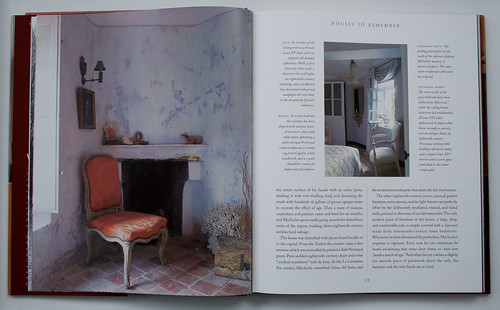
large ✦ larger
Caption for full-page photo (left) on Page 22:
"In a corner of the livint room is a French LouisXV chair with its original silk damask upholstery. Sheels, a few pieces of hite coral, a directoire tin wall light, an eighteenth-century painting, and cardboard box decorated with period wallpaper all contribute to the deceptively 'period' ambience."
Caption for photo (right) on Page 23:
"In a tiny bedroom the window has been draped with antique linen. A directoire chair with white cotton upholstery, a white antique Provençal cotton bedspread, a creamy rug from Cogolin, white woodwork, and a crystal chandelier convey an impression of crispness."

large ✦ larger
Caption for full-page photo (left) on Page 24:
"The peeling green paint on the walls of the staircase displays Méchiche's mastery of distressed effects. The stone stairs reinforced with wood are original."
Caption for full-page photo (right) on Page 25:
"The stucco walls of the guest bedroom have been deliberately 'distressed,' while the ceiling beams have been left undisturbed. A Louis XVI chair upholstered in plain white linen (actually a coarsely woven antique sheet), an eighteenth-century Provençal writing table holding a directoire lamp, and a simple Lous XVI mirror with a worn glass contribute to the room's visual calm."
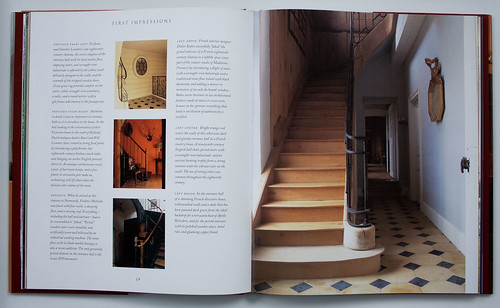
large ✦ larger
Caption for full-page photo (right) on Page 59:
"When he arrived at this chateau in Normandy, Frédéric Méchiche was faced with four walls, a decaying floor, and a missing roof. Everything - including the hall and staircase - had to be reassembled or 'faked.' 'Period' wooden stairs were installed, and artificially worn and hollowed by an industrial sanding machine. The stone floor with its black marble lozenges is also a recent addition. The only genuinely period element in the entrance hall is the Louis XVI barometer."

large ✦ larger
Caption for full-page photo (right) on Page 75:
"Frédéric Méchiche loves the directoire sytle, and in the drawing room of his guest house in the south of France he has successfully combined pale lavender walls with engravings, furniture, a mirror, and a lamp from his favorite period. The traditional pure wool rug from Cogolin is contemporary and so is the classic footstool, but the contemporary-looking sofa with a ticking mattress cover and a set of plump, cream-colored cushions is an antique metal directorie bed. Méchiche chose it not only because of its period, but also because its simple lines have a timeless appeal."
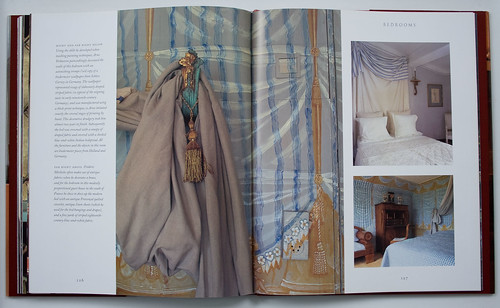
large ✦ larger
Caption for photo (upper right) on Page 127:
"Frédéric Méchiche often makes use of antique fabrics when he decorates a house, and for the bedroom in this modestly proportioned guest house in the south of France he chose to dress up the modern bed with an antique Provençal quilted coverlet, antique linen sheets (which he used for the bed hangings and drapes), and a few yards of striped eighteenth-century blue-and-white fabric."
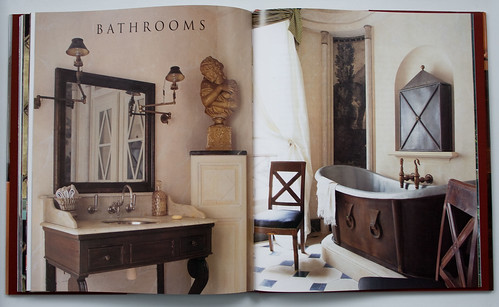
large ✦ larger
Caption for full-page photos (left & right) on Pages 136-137:
"In his Paris apartment, Frédéric Méchiche has conjured up the illusion of a perfect directoire-style bathroom using a mixture of fakery and original pieces.
"In one corner he has turned a period console table into a washstand by setting a bowl into a marble top and adding period fixtures. Early tôle oil lamps have been electrified, and the walls given a sepia-gray wash to make them resemble the color of ancient stucco. Standing on a plinth is a nineteenth-century terracotta bust, based on Houdon's well-known masterpiece La Frileuse.
"Modern comforts have not been neglected: the period doors hide a well-equipped modern shower. A directoire copper bathtub on a raised stone plinth is complemented by the lead cistern in a shallow niche above it. Swags of white voile pick up the pale colors in the stone floor inlaid with black cabochons. The room's rounded corners have been adorned with panels of nineteenth-century grisaille wallpaper, printed by Dufour and still available today. The neoclassical columns are topped with capitals that Méchiche had specially cast in resin."



